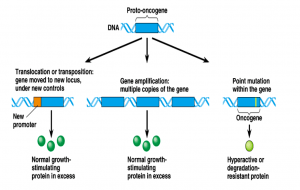Oncogenes, Proto-Oncogenes and Retroviral Oncogenes
Oncogenes
Cancer is the result of changes in critical regulatory genes that control cell proliferation , differentiation and survival. Mutations in two broad gene classes: proto-oncogenes (e.g. ras) and tumor-suppressive genes (e.g. Anaphase Promoting Complex; APC)—play key roles in cancer induction. These genes encode many kinds of proteins that help control cell growth and spread. Virtually all human tumours have gene-inactivating mutations that normally act at different cell-cycle checkpoints to stop cell progress through the cell cycle if a previous step has occurred incorrectly or if DNA has been damaged.
Proto-oncogene
Proto-oncogene is a normal gene that regulates cell growth and differentiation. Proto-oncogenes are involved in signal transduction and mitogenic signal execution, usually through their protein products. Six types of proteins encoded with proto-oncogenes are involved in cell growth control:
Class I: Growth Factors
Class II: Receptors for Growth Factors and Hormones
Class III: Intracellular Signal Transducers
Class IV: Cell-Cycle Control Proteins
Class V: Proteins that affect apoptosis
Class V: Nuclear Transcription Factors
Transformation of proto-oncogenes to oncogenes
The proto-oncogen converts to an oncogene due to mutation. Conversion, or activation, of a proto-oncogene to anoncogene generally involves a gain-offunction mutation. A gain in function mutation is a mutation that increases the gene expression by enhancing protein activity; in contrast, the loss of function mutation results in reduced or suppressed protein function.
Following mechanisms can produce oncogenes from the corresponding protooncogenes:
- Point mutation (i.e. change in a single base pair) in a proto-oncogene resulting in a constitutively active protein product.
- Chromosomal translocation that combines two genes to produce a hybrid gene encoding a chimeric protein whose activity, unlike that of the parent proteins, is often constitutive (continuous gene expression).
- Chromosomal translocation, which places the growth regulatory gene under the control of another promoter that causes inappropriate expression of the gene.
- Amplification (i.e. abnormal DNA replication) of the DNA segment, including proto-oncogene, in such a way that numerous copies exist, leading to overproduction of the encoded protein.
An oncogene formed by either of the first two mechanisms encodes an oncoprotein that differs from the normal protein encoded by the corresponding proto-oncogene. On the other hand, the other two mechanisms produce oncogenes whose protein products are identical to normal proteins; their oncogenic effect is due to production at higher than normal levels or production in cells where they are not normally produced.

Retroviral Oncogenes
Starting in 1911, Pioneering studies by Peyton Rous led to an initial recognition that a virus could cause cancer when injected into an appropriate host animal. Many years later, molecular biologists have shown that Rous sarcoma virus (RSV) is a retrovirus whose RNA genome is re-transcribed into DNA, which is incorporated into the host cell genome. RSV is one of the best-studied retroviruses to infect chicken. RSV contains specific genetic information responsible for the transformation of infected cells and this oncogene found in this retrovirus causes sarcoma and is therefore called src. Subsequent studies with mutant forms of RSV have shown that only the v-src gene, not the other viral genes, are needed for cancer induction. The product of this gene is a protein kinase that phosphorylates the residues of tyrosine in other proteins. More than 40 different oncogenic reteroviruses have been isolated from a wide range of animals including chickens , turkeys, mice , rats, cats and monkeys.